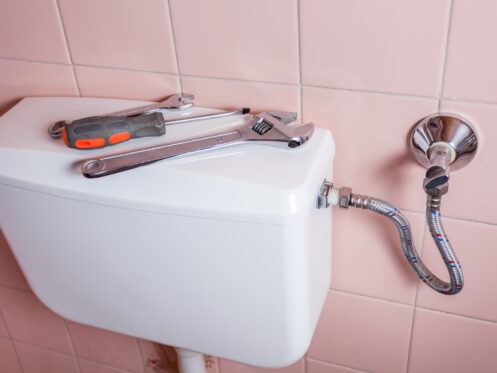The convenience of your Lincoln, NE, household relies heavily on common fixtures working properly. Unfortunately, since your toilets and sinks are used so regularly, it’s not uncommon for them to encounter unexpected issues. Navigating pesky clogs and strange leaks can be daunting for the average homeowner. Fortunately, some common plumbing issues can be addressed with these helpful tips. However, more complex problems should always be left to experienced plumbing professionals.
Understanding Your Toilet
Learning how to identify the different parts of your toilet’s anatomy will make it easier to pinpoint problems. A standard toilet will consist of a tank attached to a bowl. The tank, which is often a rectangular container on the back of the toilet, houses the toilet’s water supply. Within it, you’ll also find its essential components, like the flush valve, fill valve, flapper, and float.
Toilets activate when you press the flush lever, which allows the water from the tank to rush down into the bowl. The waste is swept away into your sewer line, and the tank is refilled with fresh water. New water comes in from the flexible supply line that you can find near the base of the toilet. During repairs, you’ll often have to run off the supply of water to the tank to avoid spillage. The wax O-ring at the base of the fixture prevents leaks and unpleasant sewage smells.
Common Toilet Problems
Regular toilet clogs can point to poor septic habits or a problem deep within your sewer line. This issue is often caused by flushing inappropriate items down the toilet, such as cotton swabs, used cat litter, feminine hygiene products, or medications. However, you can also run into this issue if you use too much toilet paper or items like “flushable” wipes that aren’t truly septic-safe. Fixing this issue can be as easy as using a plunger or snake and manually removing the blockage. You can prevent future clogs by ensuring your family follows responsible flushing habits. Regular drain cleanings and plumbing maintenance can also stop debris from accumulating inside your home’s pipes.
A weak-flushing toilet is another common issue that can quickly increase your water costs. It occurs when your toilet doesn’t have enough water in the tank to efficiently wash down waste. This can require you to flush several times, wasting your time and increasing your water consumption. A weak flush may result from a compromised flush valve, a lack of water, or clogs within the toilet’s plumbing. You can attempt to fix this issue by adjusting how much water is in the tank. It may be beneficial to replace the valve or use a snake to remove mineral blockages. It can be difficult to determine what’s causing the weak flush, which is why it’s often recommended to bring in a professional.
Some malfunctioning toilets will run continuously. This is often caused by a broken fill valve or flapper. This can quickly take a toll on your monthly costs and the toilet’s efficiency. You’ll find flappers and fill valves stocked in most home improvement stores. Be sure to choose replacement parts that match your toilet’s model and make. If you’re reluctant to make significant changes to your fixture, you can trust an expert to complete the repair. Some toilets come with limited warranties that can help you cover the cost of changing your components. They may require you to return to the original store for assistance or to work with a certified plumber.
Toilets can also struggle with an issue called phantom or ghost flushes. This is when you’ll hear your toilet flush spontaneously while not in use. Phantom flushes tend to waste a lot of water, especially if this problem is occurring frequently. They typically relate to faulty flapper valves or tank leaks. If you encounter this problem, you should fully examine the bowl and tank for any visible damage. Replace your worn-out flapper if necessary.
A leaking toilet presents a whole new level of danger to your home. Toilet leaks can start very small and out of sight, allowing moisture to accumulate in your walls and under your floors. By the time you notice the problem, you could already be struggling with a rampant mold and mildew issue. When your monthly water bills begin climbing, make sure to check all your fixtures for loose connections, dampness, or dripping. Water can easily leak from cracks in your bowl or tank and pool around the fixture. Listen closely for unexpected flushing or running noises. You can also put food dye into the toilet to see if the color makes its way into various parts of the toilet. This process helps you find subtle leaks.
How to Prevent Toilet Issues
The most frequently experienced toilet problems can be entirely avoided by investing in proper maintenance for your toilet. Consider scheduling regular maintenance with a professional to clean your drains and check your fixtures. Along with protecting your toilet, a plumbing inspection can also protect the other sinks, showers, and tubs in your home. Don’t forget to complete your own check-ups for visible damage, leaks, cracks, or strange odors.
Routinely cleaning your toilet bowl provides both aesthetic and efficiency perks. Use a suitable toilet cleaner or a vinegar mixture to ensure the jets remain clear of mineral deposits. Allowing debris to accumulate can lessen water flow, resulting in an inefficient and weak flush.
You can also tighten the bolts securing the bowl to the floor to prevent unstable wobbling. When key components like the flapper or flush begin to fail, feel free to replace them. One of the best preventative measures you can take is to practice healthy septic routines. Avoid flushing down inappropriate objects, and educate your loved ones on what shouldn’t go in the toilet. Keeping a convenient trash receptacle nearby can dissuade your children and guests from flushing wrappers and other debris.
Importance of Professional Help
Larger plumbing issues require expert assistance to ensure your plumbing system remains safe and effective. More complex issues can include major leaks, detailed installations, complicated part replacements, or troubleshooting. Attempting to fix more advanced plumbing issues with do-it-yourself hacks may only cause trouble. You may accidentally worsen the problem or compromise another part of your toilet. Working with an expert guarantees that your home will be safeguarded against emergencies like flooding or wastewater hazards. When you hire an expert, you’re gaining access to their years of plumbing experience, industry-grade tools, and valuable certifications.
Comprehensive Drain and Plumbing Services
If you need professional plumbing assistance in Lincoln or Omaha, look no further than John Henry's Plumbing, Heating, Air, and Electrical. We’re a local, family-owned business that can service your plumbing, heating, cooling, and electrical needs. Our team has been providing top-notch customer service and indoor comfort care since we opened our doors in 1996. Trust us to repair or maintain your boiler, heat pump, geothermal system, air conditioner, or furnace. We can also service your home’s major fixtures and drains. Keep our experienced team in mind the next time you need 24/7 emergency repair service.
Call John Henry's Plumbing, Heating, Air, and Electrical today to schedule an appointment.

